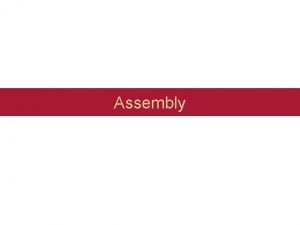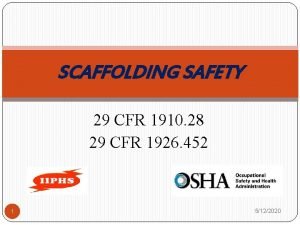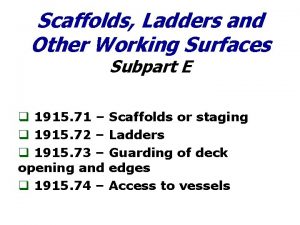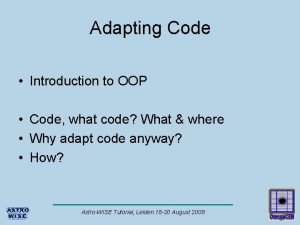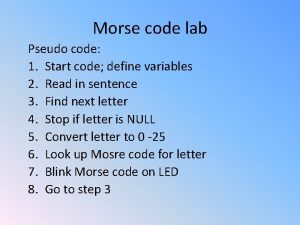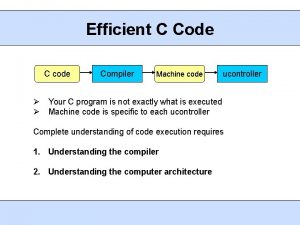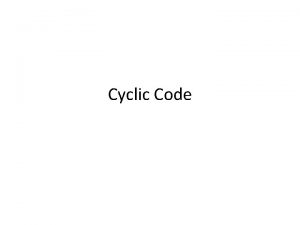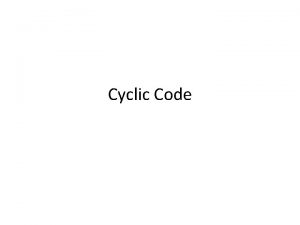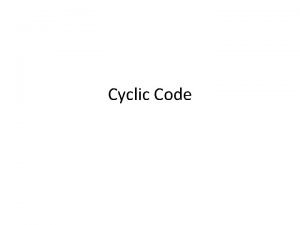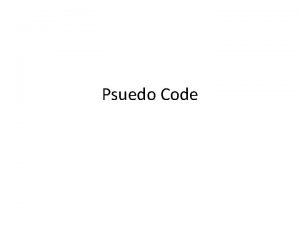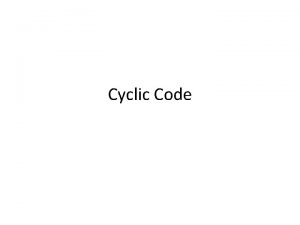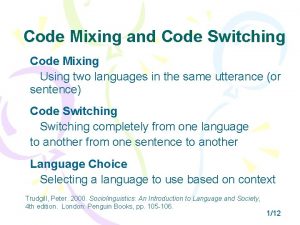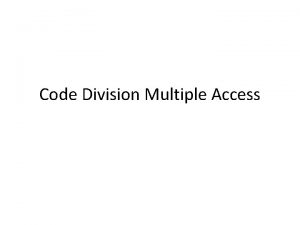Code of Practice for Access Working Scaffolds March






























- Slides: 30

Code of Practice for Access & Working Scaffolds March 2019

1) Introductions 2) Purpose of the Code of Practice Overview 3) Explanation of Changes to Code of Practice 4) Implementation of the Code of Practice 5) Opportunity for Questions

Purpose The aim of this Code of Practice is to provide practical guidance to scaffold erectors, contractors and users of scaffolding on the requirements and prohibitions set out in the relevant statutory provisions.

This Code of Practice came into effect on 1 st January 2019, replacing the Code of Practice for Access and Working Scaffolds issued by the Health and Safety Authority in 2009. This followed public consultation, including the Construction Safety Partnership Advisory Committee (CSPAC), the CIF, the National Association of Scaffolding and Access Contractors (NASAC) and the Irish Congress of Trade Unions. Changes to the Code of Practice

1) All scaffolding requires a design: This requirement includes allowance for proprietary system scaffolding manufacturer’s designs to be used for standard configurations (and other standard designs, such as TG 20), to be used as appropriate). Key Changes to COP (from 2008 version)

Standards

Cuplok Layher K-Stage System Plettac Metrix Examples of Scaffolding Manufacturer’s Designs

2) Consider Scaffold Design & Co-ordinate with Designers: An increased emphasis on the requirement to identify if a bespoke design scaffold is necessary at the earliest possible stage of a project and for the Project Supervisor Design Process to co-ordinate this temporary works design with the permanent works designer. Key Changes to COP (from 2008 version)

3) Role of Temporary Works Coordinator Introduction of the Temporary Works Coordinator to assist the project supervisors in their duties including helping effective communication and coordination between the PSDP, designers, the PSCS and the contractors involved in the temporary works/scaffolders. Key Changes to COP (from 2008 version)

4) Select Collective Protection Measures Further requirements for prioritising collective protection measures for scaffolders while erecting, modifying and dismantling scaffolding. The use of leading guard rails and scaffold step systems is introduced and the removal of the previous allowance for scaffolders to work off partially boarded decks. Key Changes to COP – continued

5) Loading Bays The removal of allowance for a non-scaffolder to remove handrails under certain circumstances such as when loading materials, and the emphasis on providing appropriate gate systems at loading bays that maintain edge protection to workers during loading operations. Key Changes to COP – continued

6) Precautions when Erecting, Modifying & Dismantling Scaffolding Further requirements for prioritising collective protection measures for scaffolders while erecting, modifying and dismantling scaffolding. The use of leading guard rails and scaffold step systems is introduced and the removal of the previous allowance for scaffolders to work off partially boarded decks. Key Changes to COP (from 2008 version)

7) Provision of Stairway Access The requirement that stairway access should be provided where it is reasonably practicable to do so, particularly where there is a high usage rate and/or where materials or tools need to be carried frequently by hand. Key Changes to COP (from 2008 version)

8) Hot Works The requirement for using flame retardant sheeting material for sheeting scaffold that will have hot works carried out in or near it, or that is erected near the public. Key Changes to COP (from 2008 version)

9) Protection from High Winds Requirements to ensure all decking boards are adequately secured and emphasis on the risks of displacement of boards due to high winds. Key Changes to COP (from 2008 version)

10) Reduction in Maximum Gap Reduction of maximum gap between scaffold deck and the structure from 300 mm to 225 mm. Key Changes to COP (from 2008 version)

11) Storage & Inspection of Scaffold Boards Requirements for the inspection of decking boards for defects and for the correct storing of timber boards when not in use. Key Changes to COP (from 2008 version)

12) Training of Persons Inspecting Scaffolding Key Changes to COP (from 2008 version)

13) Updates from Legislation & Standards Technical updates with regards to references to current legislation and standards Key Changes to COP (from 2008 version)

14) Amended GA 3 Form Provision of new template GA 3 form for scaffolds incorporating ‘in-use’ checklist Key Changes to COP (from 2008 version)

Key Changes to COP (from 2008 version) 15) New Illustrations Some illustrations were removed and replaced in the latest Code of Practice to reflect recent changes.

Implementation of the Code of Practice

Inspection and Handover

Inspection Checklists

Certificate of Handover

Log Inspections

GA 3 Form

Opportunity for Questions Please type your question into Zoom. Your question will be treated anonymously and we will endeavour to provide adequate clarifications.

CIF Training Courses - Scaffolding Two CIF Course Offerings: • Managing & Inspection of Scaffold Training Programme • Code of Practice for Access & Working Scaffolds - Update 2018 Who should attend the CIF’ Scaffold Training Programmes? This program is an update requirement for those who have already competed the 1 day CIF Management & Inspection of Scaffolding program and priority will be given to these delegates as it will allow their CIF Safety Management card or the New CIF Verification of Competency card to be update. • Those delegates who are attending whom have already completed the 1 -day CIF Management & Inspection of Scaffolding program since 2 nd December 2008 will be required to attend the half day which will update their current CIF Safety Management Card or the New CIF Verification of Competency Card. Those delegates who have completed the CIF Management & Inspection of Scaffolding program prior to 2 nd December 2008 will now need to repeat the one-day course which will be in an update format covering the key changes. For bookings, click on links provided: https: //ciftraining. ie/product/code-of-practice-for-access-working-scaffolds-update-2018/ https: //ciftraining. ie/product/management-and-inspection-of-scaffolding-training-programme/

Thank You!
 Contigs and scaffolds
Contigs and scaffolds Assembly sequence diagram
Assembly sequence diagram Types of scaffolding ppt
Types of scaffolding ppt Osha 1910 scaffolding
Osha 1910 scaffolding Poland national anthem lyrics
Poland national anthem lyrics Code commit code build code deploy
Code commit code build code deploy Smart work vs hard work
Smart work vs hard work Cold working advantages
Cold working advantages Hot working and cold working difference
Hot working and cold working difference Differentiate between hot working and cold working
Differentiate between hot working and cold working Pembentukan logam
Pembentukan logam Terminal access controller access-control system
Terminal access controller access-control system Terminal access controller access-control system
Terminal access controller access-control system 3-5 practice working with sets form g answer key
3-5 practice working with sets form g answer key Eti base code
Eti base code Fspos vägledning för kontinuitetshantering
Fspos vägledning för kontinuitetshantering Typiska drag för en novell
Typiska drag för en novell Tack för att ni lyssnade bild
Tack för att ni lyssnade bild Ekologiskt fotavtryck
Ekologiskt fotavtryck Varför kallas perioden 1918-1939 för mellankrigstiden?
Varför kallas perioden 1918-1939 för mellankrigstiden? En lathund för arbete med kontinuitetshantering
En lathund för arbete med kontinuitetshantering Underlag för särskild löneskatt på pensionskostnader
Underlag för särskild löneskatt på pensionskostnader Vilotidsbok
Vilotidsbok A gastrica
A gastrica Vad är densitet
Vad är densitet Datorkunskap för nybörjare
Datorkunskap för nybörjare Stig kerman
Stig kerman Mall debattartikel
Mall debattartikel Delegerande ledarstil
Delegerande ledarstil Nyckelkompetenser för livslångt lärande
Nyckelkompetenser för livslångt lärande Påbyggnader för flakfordon
Påbyggnader för flakfordon

